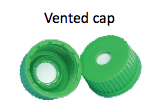For items that are not identified specifically as chemical, biological, or radioactive waste, refer to the UVM Recycling Guide for details about how other items (e.g. batteries, light bulbs, and old lab equipment) are collected on campus.
Unknown Chemicals
"Unknowns" are chemicals that are found in the lab either with an illegible label or no label at all that lab workers no longer know the contents. We cannot guess at what these wastes are. There is a strict and expensive protocol that Safety staff are required to follow in order to manage this type of waste. Please inspect your chemicals monthly as required by the Lab Safety Program to eliminate or minimize unknown chemicals in your lab.
If you find an unknown in your lab, please tag it for pickup with as much information as possible. If you have multiple unknowns, each container needs individual tags.
Assorted Batteries
Batteries are generally collected throughout campus in brown battery buckets. If you have a bag of batteries in your lab, this can be tagged as waste for pickup. Please estimate the amount in pounds.
NOTE: Large lead acid batteries, or any battery that is swollen and/or leaking, should be tagged immediately for disposal.
Chemically-Contaminated Sharps
Biologically contaminated sharps also contaminated with the residues of hazardous chemicals can be managed in the same red, puncture-proof container as all other sharps in the lab. There is NO need to manage these as a separate waste stream. Please do not label the container with a lab waste accumulation sticker. Seal, lock, and place full sharps box inside of a biohazard box when full.
If you do not have a biobox, sharps, and their containers, can be handled like other chemical wastes. Use an accumulation label to identify the residues (e.g. solvents, etc.) that contaminate the sharps. Once full, tag for waste pickup.
Containers of Highly Hazardous or Reactive Chemicals
Containers of highly hazardous or reactive chemicals are required to be securely closed and tagged for waste disposal. Never re-use these types of containers to collect waste.
Contaminated Debris: broken glassware, gloves, pipettes, etc.
Debris that is contaminated with hazardous chemicals should be collected in a clear bag or in a cardboard box lined with a clear plastic bag and tagged as chemical waste for disposal. Never use a red biohazard bag to collect chemically contaminated glassware or debris.
Glassware contaminated with infectious material should be placed in a puncture-proof container and then placed in a biohazard box. For information about biological waste please follow this link to the biowaste management.
Glassware contaminated with radioactive contaminants should be decontaminated and Radiation Safety staff should be notified. For information pertaining to radioactive waste management follow this link to the Radiation Safety Office (RSO) website.
Light Bulbs
Burned out fluorescent lights, compact light bulbs, UV light bulbs, etc. are considered Universal Waste in the State of Vermont and should be removed from the fixture and carefully placed back inside of the cardboard box that they came in to prevent breakage. Email safety@uvm.edu, call 802-656-5408, or submit a waste tag for intact light bulb pickup.
Broken light bulbs are considered hazardous waste and should be collected in a clear bag that can be sealed inside of a cardboard box. Fill out a lab waste tag and enter tag online for pickup.
Mixed waste
Since the management and disposal of mixed wastes is more complex and costly, please contact safety@uvm.edu before you generate any mixed lab waste such as the combination wastes described below.
- Chemical and biological waste,
- Chemical and radioactive waste, or
- Biological and radioactive waste.
Mixed waste combinations should only be collected with prior approval.
Old Laboratory Equipment
Old lab equipment needs to be checked by UVM ITSto have hazardous components removed prior to safe disposal as scrap metal or electronic-waste. Labs are required to use the Surplus Disposal Form for any equipment to be disposed appropriately.
Pump Oil and Contaminated Rags
Used oil, and oil-contaminated rags/debris, is regulated in Vermont. This means the oil and debris must be collected, labeled, and disposed as hazardous waste. Here are a couple examples:
- Vacuum pump and silicon oils;
- Vehicle crankcase oils, transmission fluids, and power steering fluids;
- Hydraulic, compressor, and straight cutting oils;
- Tramp oil and oil drained from evaporators.

